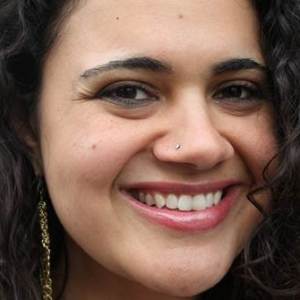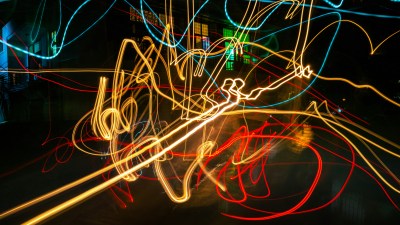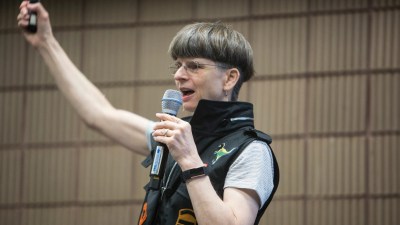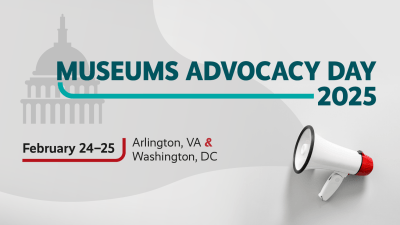
Greetings, and Happy New Year!
This is Sage Morgan-Hubbard and Megan Lantz from AAM writing to share some of our top takeaways from Museums & Schools: The LA Convening. AAM co-hosted this event with the Partnership for Los Angeles Schools at the Natural History Museum of Los Angeles County on Tuesday, November 28. Our aim was to spark dialogue about the central role museums can play in increasing equitable access to quality public education and to facilitate meaningful, multi-year partnerships between public schools and area museums for the benefit of some of LA’s most deserving, high-needs students.
 We kicked off the day with formal welcomes and an introduction circle followed by an engaging keynote from Rory Pullens, (pictured to the left) the Senior Executive Director of Arts Education, Los Angeles Unified School District (LAUSD) who spoke to both the already developed partnerships between museums and schools in the Los Angeles area but also the possibilities for the future. We then had an activity where all participants shared a moment of success followed by a great museum stakeholder panel of three phenomenal museums (Sarah Jesse, Vice President of Education at LACMA, Chelo Montoya, Education Director at California African American Museum, and Molly Porter, Director of Education at Natural History Museum of Los Angeles County) and their best practices and advice to the field for effective partnerships.
We kicked off the day with formal welcomes and an introduction circle followed by an engaging keynote from Rory Pullens, (pictured to the left) the Senior Executive Director of Arts Education, Los Angeles Unified School District (LAUSD) who spoke to both the already developed partnerships between museums and schools in the Los Angeles area but also the possibilities for the future. We then had an activity where all participants shared a moment of success followed by a great museum stakeholder panel of three phenomenal museums (Sarah Jesse, Vice President of Education at LACMA, Chelo Montoya, Education Director at California African American Museum, and Molly Porter, Director of Education at Natural History Museum of Los Angeles County) and their best practices and advice to the field for effective partnerships.
Afterwards, we enjoyed a networking lunch and then Rubi Fregoso, one of our masters of ceremony and the Manager of Arts Education at the Partnership for Los Angeles Schools facilitated a panel of incredible school stakeholders from three of their 18 schools (Angela Cash, Assistant Principal, Ritter Elementary School and Leimbach-Hollingsworth, Restorative Justice Coordinator/Arts Lead, Jordan High School, and Dharini Kumarasiri, Special Education Teacher, Sunrise Elementary School). We have drawn from many of their comments below for our takeaways. We then put the advice into action with in-depth partnership building time at our tables to further develop concrete collaborations between museums and schools and museums with each other to better support area youth. We closed with another circle and “One Small Thing” commitments. Of course, we couldn’t be at a museum campus without taking advantage of the museums themselves so the last but certainly not least element of the day’s convening were two optional tours of the Natural History Museum of Los Angeles County and the California African American Museum.
We look forward to staying in touch with the participating 75+ museum and school professionals and learning how the relationships forged on the 28th take root and grow. We hope that these partnerships might serve as scalable models for school/museum collaborations that can be replicated throughout the city and nation.
There were many wonderful things that emerged from a truly jam-packed day. Please review our Storify for more images. In the meantime, here are the top takeaways gleaned from the day’s events on developing meaningful school and museum partnerships:
- LISTEN: Meaningful school/museum partnerships aren’t necessarily an “if you build it, they will come” endeavor. Museum-site based AND school-site based activities– whether professional development focused, for teachers, or direct programming for students– need to not just be in multiple places but informed by multiple perspectives. Rory Pullens gave a great example of the new Lucas Museum of Narrative Art coming to LA and how their leadership approached LAUSD to ask what they desired in a partnership before even hiring their first education director. We need to serve and listen to each other reciprocally!
- RESEARCH: Working through the vast network of museums that exist as potential partners is overwhelming for capacity-strapped schools– often prohibitively so. Partners can help fill that void in sparking those connections and wading through the multitude of options. Instead of reinventing the wheel and starting a program from scratch, SUPPORT EACH OTHER and add on to an already existing project with another museum so that you can more deeply reach your targeted populations and provide more wrap around museum support.
- GIVE: Museums offer an opportunity to re-energize and revitalize teachers who are burning out. Yes, it’s great to give them Professional Development. But also invest in giving them, personally, a museum-based experience. It can be as simple as a membership or free visit passes for their families to visit in their leisure time.
- FEED: We all function better when well fed. Where can the students eat lunch? Can it be subsidized? Are their grants you can apply for food? We want to feed young minds AND bellies with our work.
- TRANSPORT: Transportation is key. Nothing is happening without provided buses. Public transportation is often not an option. And having a healthy degree of school-site based programming is critical. What are the schools or museums in your neighborhood? Can anyone walk to your site and can transportation be built in to the budget up front? Can you distribute gift cards for gas? Buses are often the most significant cost for (and roadblock to) more partnerships.
- INCLUDE & EXPAND: Museum experiences need to be inclusive and engaging for all students: students who have experienced trauma, special education populations, students from poverty, students from underrepresented backgrounds, etc. Many schools serve student populations that have experienced significant trauma, and there is an urgent need for building empathy and confidence, as well as giving voice. Museums can play a key role in this, but we need to figure out how to articulate that value. It’s also imperative to demonstrate how partnering with a museum will reinforce what already has to be happening in the classroom. Aligning exhibits with school standards is just one example.
- TEACH: The ultimate indicator of whether or not a student will become a life-long museum-goer is if they come with their family as a child. Yet high-needs/low-income students often have their first museum experience as part of a public school field trip. As Angela Cash mentioned, family members often want to join students on their visits to museums, but there isn’t adequate funding. How can we harness families’ interests in accompanying their kids? There are innovative ways to engage families, such as handing out passes, making it a prize, encouraging students to come back with their parents and “be the docent.” We should share these with kids and teachers as part of their museum visit preparation.
- LEARN: Learn about your local community needs from your local community directly. Figure out the specific nuances and count on your local museum network to find out more details. For example, teachers and principals require different methods for engagement (on the part of museums who would like to partner with them) as distinct gatekeepers to students at public schools. Each county, state, and school district are different. DO NOT BE AFRAID to ask questions and utilize your network and peers.
- BUILD: Build communities of practice. Museum educators working with each other to build programming collaboratively in their cities works best and helps address capacity issues. It is great to draw from the experience of others and not have to start from scratch. We are stronger and more effective when we learn from one another and build TOGETHER! (Perhaps start with some of our great colleagues on the Museum stakeholder panel)
- ENJOY: Host teacher appreciation night(s) in the evenings where teachers are introduced to the museum (including exhibitions, programming etc.) in a fun, party-like atmosphere. Serve food, wine and/or snacks, include tours and curator talks. Give away free swag and passes for follow-up visits, or even better, memberships to your museums. Build your school base by gathering emails and including these teachers in focus groups. Other ways of spreading the word: tabling at teacher conferences, new teacher inductions, go to/ recruit from education departments at local universities with schools of education, have multiple touch-points over the course of the school year: beginning, middle, and end, etc. Go to where teachers are! They are looking for high-quality field trips, so be there to give them pamphlets and standards-aligned programs so that teachers have an easier time making the case to their admins that your museum is worth visiting. If you have any additional funds, compensate teachers for their work and give them funding up front for transportation and field trips. If you have any teachers you already have a relationship with, ask them for recommendations. Teachers are going to be your best gatekeepers to access other teachers. Let the love and passion for the work lead the partnership!
- When in doubt, ask Rory Pullens to speak.He is enthusiastic and inspiring to us all! (You can follow him @RoryPullens on Twitter)
Did you attend this convening and have more thoughts you would like to add? Please fill out our survey and add your voice to the mix. Want to host or help bring a similar “Museums & Schools” convening to your city? Please let us know by contacting our Vice President of Development, Arthur Affleck at aaffleck@aam-us.org. Thank you and we look forward to hearing your thoughts and top takeaways as well!










Comments